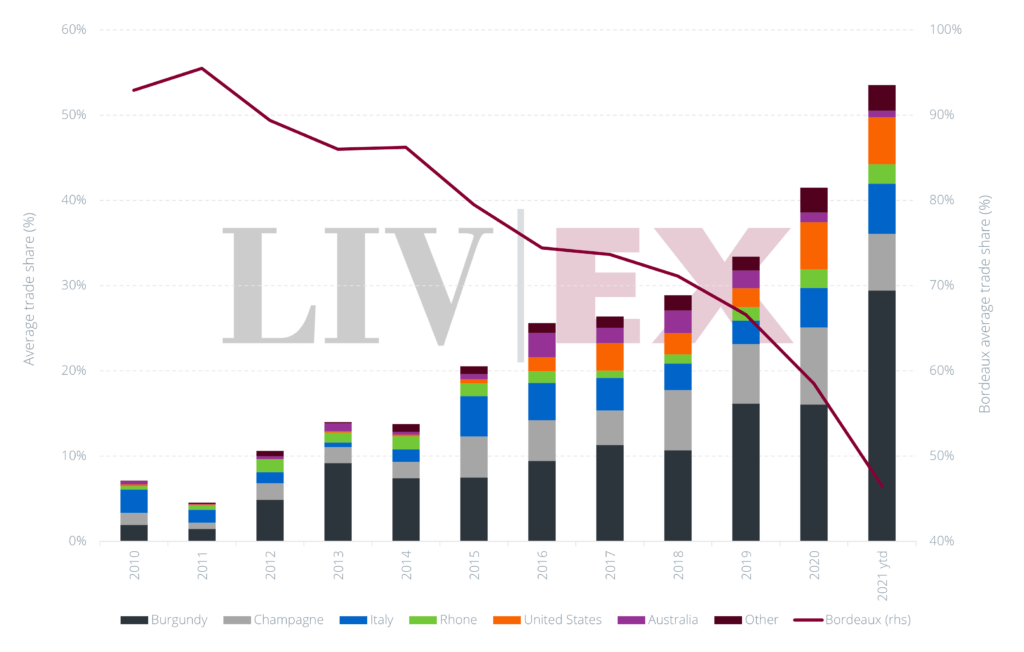- The secondary market in Asia is following the broader trend towards greater diversity.
- Bordeaux accounted for 93% of the market in 2010, today it is under 50%.
- Nonetheless, Lafite remains the leading label traded by value.
 The overall trend in the secondary fine wine market is greater diversity. More wines from established and emerging regions and sub-regions coming to market and eroding the former dominance of Bordeaux.
The overall trend in the secondary fine wine market is greater diversity. More wines from established and emerging regions and sub-regions coming to market and eroding the former dominance of Bordeaux.
Although Bordeaux labels remain central to the top wines traded in Asia, as examined in a post yesterday, the region is no exception to the trend either.
The market in 2010
In 2010 the fine wine market was at the height of its Asian-led bull run. Bordeaux, in particular the First Growths, was the fuel, accounting for 93% of trade in Asia.
Lafite, as is well known, was the biggest label in the region. Of the top traded wines in Asia at the time, the first seven were all Lafite; mostly the Grand Vin but also the 2007 Carruades. The First Growth’s 2004 vintage was the leading vintage by value that year.
Italy (2.7%), Burgundy (2%) and Champagne (1.4%) were the only other regions with any notable market share.
The market in 2020
 In 2011, however, the market turned. Asian buyers swiftly abandoned a tentative foray into En Primeur and new laws clamping down on graft had a knock-on effect on the secondary market as a whole.
In 2011, however, the market turned. Asian buyers swiftly abandoned a tentative foray into En Primeur and new laws clamping down on graft had a knock-on effect on the secondary market as a whole.
Bordeaux felt the brunt of this downturn most severely and over the course of the following decade has seen its market share slide.
In the wake of this, other regions have flourished. Following the broader global trend, Burgundy quickly rose to prominence in Asia and now accounts for a 16% market share.
In 2020, with the exception of Bordeaux, Australia (which both declined) and Burgundy (which held steady), all other major regions hit a record high market share in Asia.
Australia suffering as a result of the trade war between it and China, which has resulted in huge import tariffs on wine.
The market now
These trends look well-entrenched so far in 2021. Burgundy is currently well-ahead of its 2020 total. Italy, the Rhône and USA are roughly on par. It is only Champagne that is currently lagging behind.
With no sign of as reprieve in the trade dispute Australia’s market share has also dipped back below 1% for the first time since 2015.
Down but not out
As can be seen in the table, Bordeaux’s trajectory continues to ebb lower. It would be wrong, however, to imagine Bordeaux’s days are somehow numbered.
It is true, that it has gone from a 93% to a 59% share of total trade in Asia over the course of a decade. That 59% share, though, was far above the overall average for Bordeaux trade in 2020 (which was 42%).
Furthermore, although an increasing diversity in trade by volume and value has been observed, Lafite remained comfortably the most traded wine by value in Asia last year and remains so in 2021.
Much may be changing in the Asian fine wine market but some things remain, resolutely, the same.
How is fine wine buying changing? Our special report discusses wine merchants’ preferred buying channels and the increasingly important role of technology in the trade.



